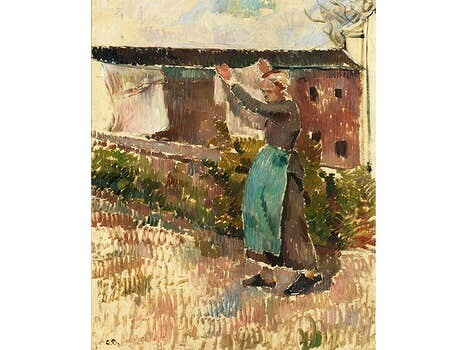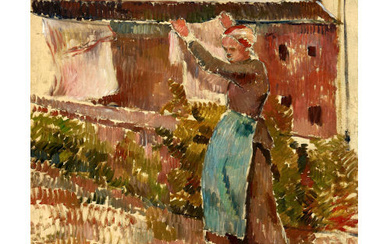Camille Pissarro, 1830 Charlotte Amalie – 1903 Paris, FEMME ÉTENDANT DU LINGE, 1887
Öl auf Leinwand.
73 x 60 cm.
Links unten monogrammiert.
Further information on this artwork
Beigegeben in Kopie ein Zertifikat von Lionel Pissarro. Verzeichnet bei Ventury Nr. 716 und Wildenstein Institut Nr. 853.
Pissarro wählt einen ungewöhnlichen Bildaufbau, an den sich das Auge des Betrachters zuerst gewöhnen muss. In horizontal aufgebauten Bändern liegen Boden, Mauern und Himmel übereinander, ohne dass zunächst eine klare Tiefenräumlichkeit erzeugt wird. Einzig die niedrige Balustrade, vor der die Bäuerin ihre Wäsche aufhängt, erzeugt eine gewisse Perspektive und Raumtiefe. Dieser Effekt wird aber durch den gleichförmigen, mal dichter, mal weniger dicht gesetzten Pinselduktus relativiert. Einzig der Himmel macht hier eine Ausnahme mit seiner dunstig-flächigen Struktur ohne klar erkennbaren Duktus. Die warme Pallette wird von Rot- und Ockertönen dominiert, unterstützt durch vereinzelte Grüntöne. Dieses Farbschema wird einzig in der türkisfarbenen Schürze unterbrochen und lenkt damit den Blick des Betrachters auf die Protagonistin. Der Maler bedient sich der Farbe, um den Raum einerseits zu konstruieren, indem er die Farbflächen mittels der weißen Laken unterbricht, und auf der anderen Seite vereinheitlicht er ihn durch die völlig gleichmäßige Behandlung aller Elemente.
Pissarro gehört zu den Gründern des Impressionismus. Obwohl zunächst für eine Karriere in der väterlichen Firma auf den Antillen vorgesehen, wandte sich Pissarro von diesem Weg ab und zog mit 25 Jahren nach Frankreich, wo er Unterricht an der École des Beaux-Arts in Paris nahm. Schnell lernte er Gustave Courbet (1819-1877), Charles-François Daubigny (1817-1878) und Jean-Baptiste Camille Corot (1796-1875) kennen und sah sich eine Zeit lang als deren Schüler. Zudem pflegte er Kontakt zu Paul Cézanne (1839-1906) und Claude Monet (1840-1926). Mit seinen häufigen Besuchen in Pontoise, wo er die anderen Impressionisten wieder traf, befand sich der bedeutende Maler stets im Epizentrum der Bewegung. Die Begegnung mit Georges Seurat (1859-1891) 1885, zwei Jahre vor Entstehung des vorliegenden Gemäldes, veranlasste ihn, sich an der Technik des Pointilismus zu versuchen. Das Gemälde „Femme étendant du linge“ legt dafür ein seltenes Zeugnis ab. Doch zerlegt Pissarro die Farbe nicht in kleine Pünktchen, sondern verwendet einen lebhafteren und zugleich wärmeren Duktus, womit er in dieser Technik einen völlig eigenen Ansatz findet und beschreitet. (†)
Literatur:
Im Catalogue raisonné des Wildenstein Instituts, Paris, abgebildet.
Abgebildet in Cézanne et Pissarro. 1865 - 1885, Musée d'Orsay, Paris 28. Februar - 28. Mai 2006, S. 64, fig. 61. (12312822) (10)
Camille Pissarro,
1830 Charlotte Amalie, Danish-West India – 1903 Paris
FEMME ÉTENDANT DU LINGE [Woman hanging out the laundry], 1887Oil on canvas.
73 x 60 cm.
Monogrammed lower left.
Accompanied by a copy of a certificate by Lionel Pissarro. Listed with Ventury under no. 716 and Wildenstein Institute under no. 853.
Pissarro has chosen an unusual composition that takes some getting used to at first. The ground, walls and sky are laid horizontally on top of one another without creating any kind of obvious spatiality. A peasant woman is hanging up washing in front of a low balustrade, which is the only element creating a certain kind of perspective and three-dimensionality. This effect is, however, relativized by the uniform and alternatingly dense and less dense brushstrokes. The sky is the only area that is an exception with a flat misty structure and without any visible brushstrokes. The warm palette is dominated by hues of red and ochre and supported by scattered shades of green. This colour scheme is only broken up by the woman’s turquoise apron that directs the viewer's gaze to the protagonist. The painter uses colour to construct space by breaking up colour fields through white sheets on the one hand and harmonizing it by treating all elements completely uniformly.
Pissarro is a founding member of Impressionism. Although he was predestined to make his career in his father's company on the Antilles, Pissarro went down a different path and moved to France aged 25 where he trained at the École des Beaux-Arts in Paris. He quickly became acquainted with Gustave Courbet (1819-1877), Charles-François Daubigny (1817-1878) and Baptiste Camille Corot (1796-1875) and perceived himself as their student for a long time. He was also in contact with Paul Cézanne (1839-1906) and Claude Monet (1840-1926). His frequent visits to Pontoise, the epicentre of the Impressionist movement brought him in close contact with fellow Impressionist colleagues. His acquaintance with Georges Seurat (1859-1891) in 1885, two years previous to the creation of the painting on offer in this lot, prompted him to try out the techniques of Pointillism. The present painting titled “Femme étendant du linge” bears witness to this. Pissarro does not break up the colour into small dots but uses livelier and at the same time warmer brushstrokes, giving this technique his own twist and pursuing his own style. (†)
Literature:
Illustrated in Catalogue raisonné of the Wildenstein Institut, Paris.
Illustrated in Cézanne et Pissarro. 1865 - 1885, Musée d’Orsay, Paris 28 February - 28 May 2006, p. 64, fig. 61.
This object has been individually compared to the information in the Art Loss Register data bank and is not registered there as stolen or missing.
Estimate
Time, Location
Auction House
Öl auf Leinwand.
73 x 60 cm.
Links unten monogrammiert.
Further information on this artwork
Beigegeben in Kopie ein Zertifikat von Lionel Pissarro. Verzeichnet bei Ventury Nr. 716 und Wildenstein Institut Nr. 853.
Pissarro wählt einen ungewöhnlichen Bildaufbau, an den sich das Auge des Betrachters zuerst gewöhnen muss. In horizontal aufgebauten Bändern liegen Boden, Mauern und Himmel übereinander, ohne dass zunächst eine klare Tiefenräumlichkeit erzeugt wird. Einzig die niedrige Balustrade, vor der die Bäuerin ihre Wäsche aufhängt, erzeugt eine gewisse Perspektive und Raumtiefe. Dieser Effekt wird aber durch den gleichförmigen, mal dichter, mal weniger dicht gesetzten Pinselduktus relativiert. Einzig der Himmel macht hier eine Ausnahme mit seiner dunstig-flächigen Struktur ohne klar erkennbaren Duktus. Die warme Pallette wird von Rot- und Ockertönen dominiert, unterstützt durch vereinzelte Grüntöne. Dieses Farbschema wird einzig in der türkisfarbenen Schürze unterbrochen und lenkt damit den Blick des Betrachters auf die Protagonistin. Der Maler bedient sich der Farbe, um den Raum einerseits zu konstruieren, indem er die Farbflächen mittels der weißen Laken unterbricht, und auf der anderen Seite vereinheitlicht er ihn durch die völlig gleichmäßige Behandlung aller Elemente.
Pissarro gehört zu den Gründern des Impressionismus. Obwohl zunächst für eine Karriere in der väterlichen Firma auf den Antillen vorgesehen, wandte sich Pissarro von diesem Weg ab und zog mit 25 Jahren nach Frankreich, wo er Unterricht an der École des Beaux-Arts in Paris nahm. Schnell lernte er Gustave Courbet (1819-1877), Charles-François Daubigny (1817-1878) und Jean-Baptiste Camille Corot (1796-1875) kennen und sah sich eine Zeit lang als deren Schüler. Zudem pflegte er Kontakt zu Paul Cézanne (1839-1906) und Claude Monet (1840-1926). Mit seinen häufigen Besuchen in Pontoise, wo er die anderen Impressionisten wieder traf, befand sich der bedeutende Maler stets im Epizentrum der Bewegung. Die Begegnung mit Georges Seurat (1859-1891) 1885, zwei Jahre vor Entstehung des vorliegenden Gemäldes, veranlasste ihn, sich an der Technik des Pointilismus zu versuchen. Das Gemälde „Femme étendant du linge“ legt dafür ein seltenes Zeugnis ab. Doch zerlegt Pissarro die Farbe nicht in kleine Pünktchen, sondern verwendet einen lebhafteren und zugleich wärmeren Duktus, womit er in dieser Technik einen völlig eigenen Ansatz findet und beschreitet. (†)
Literatur:
Im Catalogue raisonné des Wildenstein Instituts, Paris, abgebildet.
Abgebildet in Cézanne et Pissarro. 1865 - 1885, Musée d'Orsay, Paris 28. Februar - 28. Mai 2006, S. 64, fig. 61. (12312822) (10)
Camille Pissarro,
1830 Charlotte Amalie, Danish-West India – 1903 Paris
FEMME ÉTENDANT DU LINGE [Woman hanging out the laundry], 1887Oil on canvas.
73 x 60 cm.
Monogrammed lower left.
Accompanied by a copy of a certificate by Lionel Pissarro. Listed with Ventury under no. 716 and Wildenstein Institute under no. 853.
Pissarro has chosen an unusual composition that takes some getting used to at first. The ground, walls and sky are laid horizontally on top of one another without creating any kind of obvious spatiality. A peasant woman is hanging up washing in front of a low balustrade, which is the only element creating a certain kind of perspective and three-dimensionality. This effect is, however, relativized by the uniform and alternatingly dense and less dense brushstrokes. The sky is the only area that is an exception with a flat misty structure and without any visible brushstrokes. The warm palette is dominated by hues of red and ochre and supported by scattered shades of green. This colour scheme is only broken up by the woman’s turquoise apron that directs the viewer's gaze to the protagonist. The painter uses colour to construct space by breaking up colour fields through white sheets on the one hand and harmonizing it by treating all elements completely uniformly.
Pissarro is a founding member of Impressionism. Although he was predestined to make his career in his father's company on the Antilles, Pissarro went down a different path and moved to France aged 25 where he trained at the École des Beaux-Arts in Paris. He quickly became acquainted with Gustave Courbet (1819-1877), Charles-François Daubigny (1817-1878) and Baptiste Camille Corot (1796-1875) and perceived himself as their student for a long time. He was also in contact with Paul Cézanne (1839-1906) and Claude Monet (1840-1926). His frequent visits to Pontoise, the epicentre of the Impressionist movement brought him in close contact with fellow Impressionist colleagues. His acquaintance with Georges Seurat (1859-1891) in 1885, two years previous to the creation of the painting on offer in this lot, prompted him to try out the techniques of Pointillism. The present painting titled “Femme étendant du linge” bears witness to this. Pissarro does not break up the colour into small dots but uses livelier and at the same time warmer brushstrokes, giving this technique his own twist and pursuing his own style. (†)
Literature:
Illustrated in Catalogue raisonné of the Wildenstein Institut, Paris.
Illustrated in Cézanne et Pissarro. 1865 - 1885, Musée d’Orsay, Paris 28 February - 28 May 2006, p. 64, fig. 61.
This object has been individually compared to the information in the Art Loss Register data bank and is not registered there as stolen or missing.





